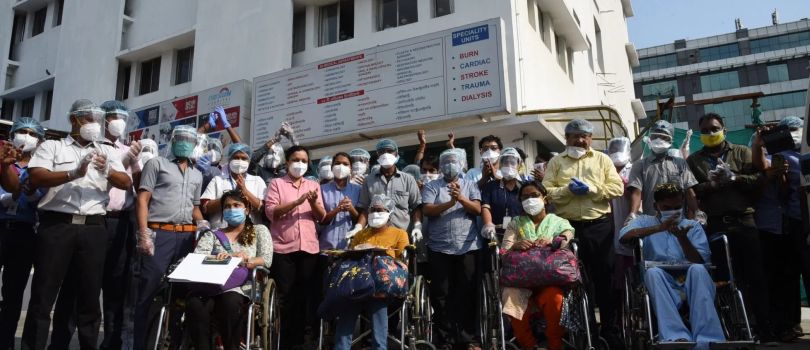New Delhi: Even as India saw the highest jump of 4,000 plus cases of novel coronavirus in a single day, and with the cases rising unabated in the country, the Health Ministry said that there was a need for a revived discharge policy for the coronavirus patients having mild and moderate symptoms. The health ministry on late Sunday evening issued a set of Frequently asked Questions (FAQ) and said, “Several countries have changed the criteria for discharge from a ‘test based strategy to asymptom based strategy’ or a ‘time based strategy.”
The ministry cited a review of the ICMR laboratory surveillance data that said, “Also indicated that after initial Reverse transcription polymerase chain reaction (RT-PCR) positive results, patients became negative after a median duration of 10 days. Recent studies have also suggested that the viral load peaks in the pre-symptomatic period (two days before symptoms) and goes down over the next seven days.”
The Health Ministry recently had reviewed the discharge policy of the patients of COVID-19 having mild/very mild/pre-symptomatic cases as well as moderate cases and severe cases.
According to the new policy, patients who are mild/very mild/pre-symptomatic cases, can be discharged after 10 days of symptom onset and no fever for three days. The patient in this case will be advised to follow home isolation for a further seven days after discharge and there is no need for testing prior to discharge as per the new policy.
Similarly, patients having moderate disease can be discharged (a) if asymptomatic for three days and (b) after 10 days of symptom onset, testing and home isolation policy is the same as the mild cases. While the earlier criteria for discharging RT-PCR positive were (a) chest radiograph had to be cleared and (b) two consecutive negative test results on RT-PCR. However, for the severe cases clinical recovery and one RT-PCR test turning negative after the resolution of the symptoms is mandatory.
The ministry answered the FAQs for general public as following:
Q: How will it be established that the patient is cured?
A: Being cured of a disease may have different connotations for the general public, treating doctors and the virologists. Unless there is a fear of resurgence of infection and subsequent transmissibility of an infection, resolution of clinical manifestation is usually taken as an evidence for cure.
Q: Is there a risk of transmission from patients discharged based on the revised criteria?
A: Available evidence does not indicate any increase in the risk of transmission from patients discharged based on the revised discharge criteria. The revised criterion also specifies that such patients will follow home isolation for a further seven days.
Q: What precautions the patient should undertake during home isolation?
A: It has to be remembered that provision for home isolation of pre-symptomatic/very mild/mild confirmed cases of COVID-19 has been made, provided that such patients are assessed to be eligible for the same in terms of their clinical status and feasibility to successfully isolate in home environment settings. This should be done after signing a self-declaration form by the patient.
Such patients (with no comorbidities) should at all times use triple layer medical mask. Patient must stay in the identified room and away from other people in home, especially elders and those with co-morbid conditions like hypertension, cardiovascular disease, renal disease, etc. They should maintain strict personal hygiene and self-monitor his/her health with daily temperature monitoring and report promptly if develops any deterioration of symptom. Detailed eligibility criteria and advisory for such patients is available at the health ministry website.
Q: Is there a need to get tested after the home isolation period is over?
A: No. As per the latest revised discharge policy, there is no need for testing prior to discharge, all presymptomatic/very mild/mild confirmed cases of COVID-19 after 10 days of symptom onset and no fever for three days. Therefore, it stands to reason that no testing is also needed for patients undergoing home isolation (pre-symptomatic/very mild/mild confirmed cases) after the home isolation period is over.
Q: What does the current discharge policy mean for patients who are being home isolated?
A: As detailed above, as far as testing is concerned, there is no need for testing after the home isolation period is over. However, (as the current discharge policy advises patients to remain in home isolation for a seven day period after discharge), the period of home isolation would end after 17 (10+7) days of symptom onset and no fever for 10 (3+7) days. The Home Isolation Guidelines dated May 10 (displayed on health ministry website) should be strictly followed.
Q: Does this policy apply to those undergoing home or facility quarantine?
A: Discharge policy is meant for patients (symptomatic/pre-symptomatic) diagnosed (using RT-PCR testing) to be suffering from COVID-19. Quarantine (home or facility) is meant for asymptomatic/healthy persons who may have been exposed to the COVID-19 infection but are not manifesting any symptoms. Therefore there is no question of discharge of such persons. However, their stay under quarantine period will remain 14 days from the date of last exposure. The MHA Guidelines dated May 5, 2020 should be followed.
The Health Ministry said that the new discharge policy was prepared in consultation with the ICMR and is in line with the Ministry of Health and Family Welfare guidelines on the categorisation of the patients based on clinical severity and their management in the 3-tier COVID facilities. (IANS)


COMMENTS